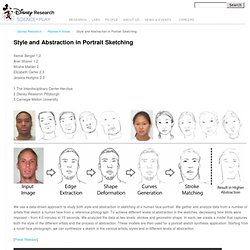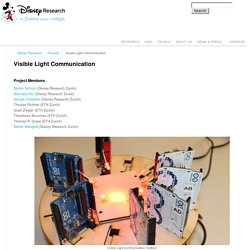

Ishin-Den-Shin. Disney Research, Pittsburgh In this project we explore the use of the human body as sound transmission medium.

Called “Ishin-Den-Shin,” a Japanese expression for communicating through an unspoken mutual understanding, the technology turns an audio message into an inaudible signal that is relayed by the human body. When the communicator’s finger slightly rubs an object, this physical interaction creates an ad-hoc speaker that makes it possible to hear the recorded sounds. A special case of Ishin-Den-Shin is when the communicator touches another person’s ear. In this case, a modulated electrostatic field creates a very small vibration of the ear lobe; the finger and the other person’s ear, together, form a speaker which makes the signal audible only for the person touched. Megastereo: Constructing High Resolution Stereo Panoramas. Project Members Christian Richardt (Disney Research Zurich)Yael Pritch (Disney Research Zurich)Henning Zimmer (Disney Research Zurich)Alexander Sorkine-Hornung (Disney Research Zurich) We present a solution for generating high-quality stereo panoramas at megapixel resolutions.

While previous approaches introduced the basic principles, we show that those techniques do not generalize well to today’s high image resolutions and lead to disturbing visual artifacts. As out first contribution, we describe the necessary correction steps and a compact representation for the input images in order to achieve a highly accurate approximation to the required ray space. Our second contribution is a flow-based upsampling of the available input rays which effectively resolves known aliasing issues like stitching artifacts.
Copyright Notice. Style and Abstraction in Portrait Sketching. Itamar Berger 1,2 Ariel Shamir 1,2 Moshe Mahler 2 Elizabeth Carter 2,3 Jessica Hodgins 2,3 1 The Interdisciplinary Center Herzliya 2 Disney Research Pittsburgh 3 Carnegie Mellon University We use a data-driven approach to study both style and abstraction in sketching of a human face portrait.

We gather and analyze data from a number of artists that sketch a human face from a reference photograph. To achieve different levels of abstraction in the sketches, decreasing time limits were imposed – from 4:5 minutes to 15 seconds. We analyzed the data at two levels: strokes and geometric shape. [Press Release] Style and Abstraction in Portrait Sketching Itamar Berger, Ariel Shamir, Moshe Mahler, Elizabeth Carter, Jessica Hodgins Presented at ACM SIGGRAPH, July 21-25, 2013, Anaheim, CA Paper[PDF, 18.3MB] – Data Set-Sketches[ZIP file, 71.5MB] – Data Set-Raw Sketches[ZIP file, 213.7MB] Geolocation. Allowing guests of entertainment parks or at cruise liners to localise themselves is an interesting technical challenge and important for new types of wireless services.

Such geolocation is typically based on cellphone determining their locations with the help of GPS or cellular base stations. Drawbacks of GPS are high battery consumption and the need for a clear view of the sky, making it impractical at cruise liners, in indoor areas, tree-covered zones, or similar environments where obstacles shadow the GPS signals. Approaches using the cellular network are not reliable and precise enough. In this project, we look at various technologies to improve the reliability of the geolocation services. We develop a station identity management system that preserves base station location privacy. Publications Collaborative GPS Localization Vladimir Vukadinovic and Stefan Mangold. Managing Base Station Location Privacy Maria Gorlatova and Roberto Aiello and Stefan Mangold.
Contact. Visible Light Communication. Project Members.

Aireal: Interactive Tactile Experiences in Free Air. Disney Research, Pittsburgh AIREAL is a new low cost, highly scalable haptic technology that delivers expressive tactile sensations in mid air.

AIREAL enables users to feel virtual objects, experience dynamically varying textures and receive feedback on full body gestures, all without requiring the user to wear a physical device. AIREAL is designed to use a vortex, a ring of air that can travel large distances while keeping its shape and speed. When the vortex hits a user’s skin, the low pressure system inside a vortex collapses and imparts a force the user can feel.
The AIREAL technology is almost entirely 3D printed using a 3D printed enclosure, flexible nozzle and a pan and tilt gimbal structure capable of a 75-degree targeting field. AIREAL is part of our long term vision for creating large-scale computer augmented environments which can deliver compelling interactive experiences seamlessly, everywhere and at anytime. [Press Release] TeslaTouch. Disney Research, Pittsburgh Loaded: 0% Progress: 0% We present Electrostatic Vibration (formerly “TeslaTouch”), a new technology for enhancing touch interfaces with tactile sensations. Electrostatic Vibration is based on the electrovibration phenomenon and does not use any moving parts. Our technology provides a wide range of tactile sensations to fingers sliding across surfaces of any shape and size, from small mobile displays to curved or wall-sized screens.
Surround Haptics: Tactile Brush Algorithm. Ali Israr and Ivan Poupyrev Disney Research, Pittsburgh Tactile Brush is an algorithm that produces smooth, two-dimensional tactile moving strokes with varying frequency, intensity, velocity and direction of motion. The design of the algorithm is derived from the results of psychophysical investigations tactile illusions such as apparent tactile motion (phi phenomena), phantom sensations (funneling illusion), saltation, etc.
Combined together they allow for the design of high-density two-dimensional tactile displays for the body using sparse vibrating arrays.